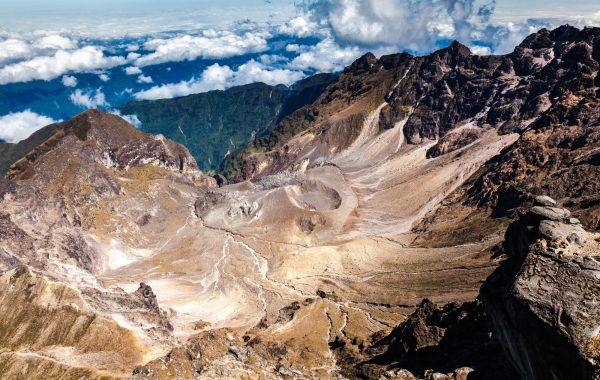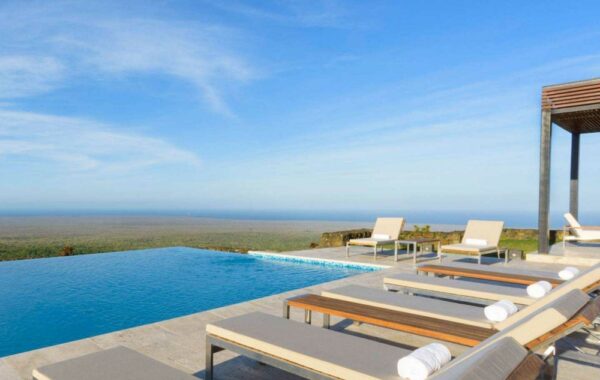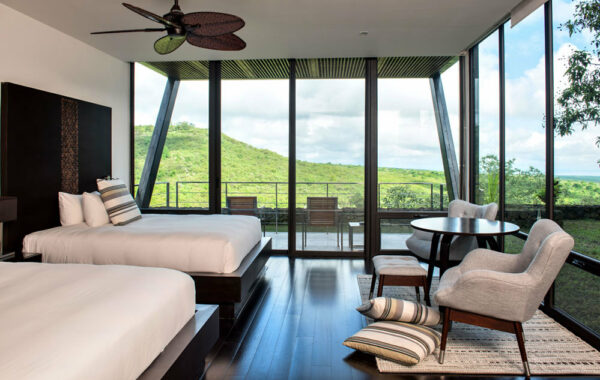Galapagos eco-lodge exploration
Luxury ecotravel at its finest
Start in Ecuador’s mountainous capital of Quito, checking out the UNESCO World Heritage-listed old town, complete with colonial architecture, beautiful churches and busy squares. From here, you’ll fly to the Galapagos Islands and Isla Santa Cruz to stay in a carbon-neutral eco-lodge atop a dormant volcano. From here, you’ll spend several days exploring Santa Cruz’s giant tortoises, sea lions and volcanos, as well as taking day cruises around nearby islands. You’ll snorkel with penguins and tropical fish, explore lava fields and learn more about the archipelago’s wildlife, before returning to your lodge each night. Transfer back to Quito for your departure.
Key information
| Destinations | Quito, The Galapagos Islands |
|---|---|
| Activity | Luxury, Nature & Wildlife |
| Physical Level | Easy |
| January - December |
Suggested itinerary

Explore colonial Quito
Day 1 in Quito
The first thing you notice about Quito is that it takes your breath away.
Not in a clichéd 'look at the amazing scenery' way; it's more of a literal 'I've just stepped off the plane at three thousand metres above sea level and I feel like I've got a 30-cigarettes-a-day habit.
Squeezed between Volcán Pichincha and a cloud-shrouded mountain range which looms broodingly over the city, Quito is moulded into an elongated strip that is thin enough to cross by foot but so long it vanishes into the horizon. Almost 1.5 million people live in this strand of urban spaghetti but despite its endless suburbs, the city's gems are conveniently concentrated in the few blocks that make up the Unesco World Heritage site of Quito old town.
As the sun sets behind Pichincha, you can see the spires of the old town and beyond it a small hill, El Panecillo ('bread loaf,' so named for its odd shape) on which stands the towering Virgin of Quito looking down over the city. In the foreground runs a long strip of park linking the old town with the anarchic bustle of the new town and in the other direction, a few kilometres north of the city, is the equator and the 'Centre of the World' science museum, a favourite of hemisphere-hopping tourists.
A stroll through the old town is a lesson into the long history of war, conquest and cultural assimilation that occurred in this city ever since the Spanish arrived in South America in the mid 16th century. The original Inca city had been destroyed by civil war immediately before the conquistadors' arrival and the Spanish wasted no time in capitalising on a divided opposition. After the annihilation of the Inca empire, the city was rebuilt according to Spanish designs but by the hands of enslaved indigenous labourers, a process which produced a unique cultural fusion, the 'Quito school of art' which is still visible in the architecture and galleries of the old town.
Meanwhile, with the winds of the Inquisition in their sails, the Spanish set about converting the native population to Christianity; churches were established on the remains of sacred sites, imposing statues were built, and the gore-filled tales of the Bible were depicted in grotesque exaggeration on carvings and paintings. In the Basilica del Voto Nacional, an emaciated Jesus, face locked in agony and with blood dripping down his arms and feet, stands crucified above crowds of genuflecting indígenas. In the Monastery of Santa Catalina, paintings warn sinners of their ultimate punishment in graphic and brutal detail.
Yet despite their best efforts, the Spanish strategy of terrifying the natives into conversion only partially worked. Cultural cross-pollination touched the religious world too, blending ancient tradition with this new faith, with often spectacular results.
Outside the cocoon of the old town, the rest of Quito carries on with its daily life. Only the occasional passing of an indígena, burdened by loads that are often larger than they are, reminds you that this busy, noisy bustle is merely the latest phase in Quito's long history.
Don't miss

Climb Pichincha Volcano
Take the cable car up to the 4,000m high lookout for magnificent views over Quito and the snow-capped mountains that surround it. If you’re feeling adventurous, you can book an organised bike up to 4,500m for even more impressive views.

Follow in Darwin’s footsteps on Isla Santa Cruz
Day 2 in Isla Santa Cruz
Almost all visitors to the Galapagos Islands will touch down in Isla Santa Cruz at some point. From beach walks at Tortuga Bay to giant tortoises at El Chato Reserve, there is plenty to see — but make sure to visit the Charles Darwin Research Centre to learn more about the wildlife you’ll encounter on your trip.
Don't miss

Walk in the hills with giant tortoises
The endangered giant tortoise is making a comeback on the Galapagos thanks to a concerted conservation effort. Head to the highlands of Santa Cruz to see these gentle giants shuffling around the hills.

Yacht excursion to Isla Bartolomé
Day 3 in Isla Bartolomé
Tiny Bartolomé is most famous for its landscapes and scenery. A set of steep steps leads to a 360-degree viewpoint over the island, looking back on black volcanic formations, marine life and striking reds and greens.
Don't miss

Penguins and Pinnacle Rock
Pinnacle Rock on Bartolomé Island is one of the most recognisable landmarks in the Galapagos. Climb its 114m summit for views before heading down to the beach to see -- and swim -- with the diminutive Galapagos penguin.

Yacht excursion to Isla Santiago
Day 4 in Isla Santiago
Once a hideout for smugglers and pirates, Isla Santiago is now best-known for Sullivan Bay, where century-old lava has solidified into bubbles and caves, and Puerto Egas, a wet landing where you can see seals, sea lions and sea birds.
Don't miss

Snorkel at Puerto Egas
Snorkelling at Puerto Egas allows you to get in the water with sea lions, sea turtles, tropical fish and even sharks – this is one of the archipelago’s premier places to get in the water.

Return to Quito
Day 5 in Quito
Return flight from Baltra Island airport to Quito for your onward connection.
Where to stay
Classic
Habitat Hotel
An iconic Galapagos hotel situated in Puerto Ayora on the waterfront of Academy Bay, Isla Santa Cruz. Hotel facilities include private deck and restaurant area with incredible panoramic views of the Galapagos Islands.
Classic
Coral 1 & 2
The perfect cruise vessels for charter groups where comfort is guaranteed. Equipped with two terraces, a dining area, lounge, library, jacuzzi and restaurant serving Ecuadorian and international cuisine.
Capacity: 36 passengers.
Superior
Sea Star Journey
Boutique yacht offering a wide range of itineraries for those wanting visit the Galapagos Islands in comfort. Featuring 8 air-conditioned suites and spacious social areas with all the luxuries and facilities of a superior first class motor yacht.
Capacity: 16 passengers.
Deluxe
M/V Santa Cruz II
Conceived for operations in remote areas, this state-of-the-art expedition vessel carries just 90 passengers and a crew of 52, including 6 naturalist guides and a medical officer. Facilities include dining/bar/lounge area, boutique/gift shop, Internet access, reading room/natural history library, glass-bottom Boston Whaler, snorkelling equipment and wet suits.
Capacity: 90 passengers.
Deluxe
Pikaia Lodge
A secluded, sustainability-focused hotel nestled on top of an extinct volcano crater, offering luxurious accommodation with an on-site restaurant, infinity pool, spa and lounge bar.
Book this itinerary
This route booked with one of our specialist tour operators would cost from $4,680pp. Pricing varies by accommodation class, and can be tailored to suit your budget.
Pricing is typically inclusive of hotels, transfers, meals, and all guided excursions and activities.
Other itineraries you might like

Machu Picchu & Galapagos cruise
An epic land and sea voyage of history and nature
Approx. 13 days
Galapagos and Amazon basin combined
Explore the highlights of Ecuador
Approx. 10 days

























